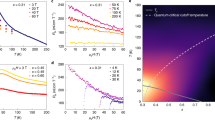Abstract
In this article I review recent theoretical work on the possibility of using tunneling and proximity effect experiments to study unconventional superconductors. The basic idea is simple: as shown in Fig. 1 one places a thin layer of some well understood conventional superconductor in good metallic contact with the superconductor one wishes to study, and then measures (e.g. by tunneling at the outer edge the conventional layer) how the superconducting properties of the conventional material are altered by its proximity to the unconventional material. To study this question theoretically one has to solve the gap equation for the inhomogeneous system. Because the symmetry and the physical origin of the pairing interaction may be different for conventional than for unconventional superconductors, it is possible that the proximity effect is different between two conventional superconductors than it is between a conventional and an unconventional superconductor. Our understanding of the nature and observability of these differences is still preliminary. A useful theoretical technique for calculating such proximity effects has only recently been proposed, and only a few calculations in simple model systems have been done. The results from this preliminary work are not encouraging: proximity etlects involving unconventional superconductivity seem to differ only in subtle ways from those involving only conventional superconductivity; further, proximity effect experiments do not seem to provide a useful method of distinguishing unconventional singlet (e.g. d-wave) from triplet superconductivity.
Access this chapter
Tax calculation will be finalised at checkout
Purchases are for personal use only
Preview
Unable to display preview. Download preview PDF.
Similar content being viewed by others
References
P. G. deGennes, Rev. Mod. Phys. 36, 225 (1964).
G. Deutscher and P. G. deGennes in Superconductivity ed. R. D. Parks ( Marcel Dekker: New York, 1969 ).
P. W. Anderson and W. F. Brinkman in The Physics of Solid and Liquid Helium, ed. K. H. Benneman and J. B. Ketterson ( John Wiley and Sons: New York, 1978 ) p. 177.
P. A. Lee, T. M. Rice, J. W. Serene, L. J. Sham and J. W. Wilkins, Comm. Cond. Mat. Phys. 12, 99, (1986).
G. E. Volovik and L. P. Gorkov, Sov. Phys. JETP 61 843, (1985).
E. I. Blount, Phys. Rev. B 32 2935 (1985).
A. A. Abrikosov, L. P. Gorkov and I. E. Dzyaloshinski, Methods of Quantum Field Theory in Statistical Physics, trans. R. A. Silverman ( Dover: New York, 1963 ).
R. Balian and N. R. Werthamer, Phys. Rev. 131 1553 (1963).
A. J. Millis, unpublished.
V. Ambegaokar, P. G. deGennes and D. Rainer, Phys. Rev. A 9, 2676 (1974).
L. J. Buchholtz and G. Zwicknagl, Phys. Rev. B23, 5788 (1981).
A. J. Millis, D. Rainer and J. A. Sauls, to be published.
J. Sauls, Z. Zou. and P. W. Anderson, unpublished.
V. B. Geshkenbein and A. I. Larkin, JETP Lett. 40, p. 395, 1986.
A. J. Millis, to be published.
A. J. Millis in Proceedings of the International Conference on Materials and Mechanisms of Superconductivity 1985 eds. K. Gschneider and E. L. Wolf, Physica 135B, p. 69 (1985).
W. L. McMillan, Phys. Rev. 175 537 (1968).
K. Scharnberg, D. Fay, and N. Schopohl, J. de Physique 39, C6 - 481 (1978).
E. W. Fenton, Sol. State. Comm. 54, 705 (1985).
G. Eilenberger, Z. Phys. 214, 195. (1968).
J. W. Serene and D. Rainer, Phys. Rep. 101, 221 (1983).
A. V. Zaitsev, Zh. Exph. Teor Fiz. 59 1015 (1984).
Author information
Authors and Affiliations
Editor information
Editors and Affiliations
Rights and permissions
Copyright information
© 1987 Plenum Press, New York
About this chapter
Cite this chapter
Millis, A.J., Rainer, D., Sauls, J. (1987). Proximity Effects between Conventional and Unconventional Superconductors. In: Wolf, S.A., Kresin, V.Z. (eds) Novel Superconductivity. Springer, Boston, MA. https://doi.org/10.1007/978-1-4613-1937-5_27
Download citation
DOI: https://doi.org/10.1007/978-1-4613-1937-5_27
Publisher Name: Springer, Boston, MA
Print ISBN: 978-1-4612-9076-6
Online ISBN: 978-1-4613-1937-5
eBook Packages: Springer Book Archive




